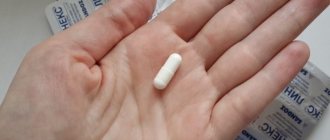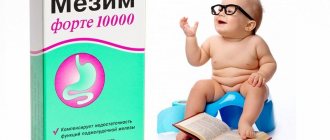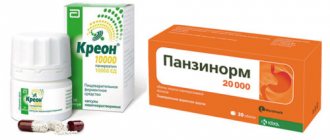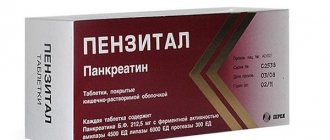The importance of antibiotics
Literally translated from Latin, “antibiotic” (anti bios) means “against life.” Despite such a frightening definition, it was the antibacterial drugs that made history about a century ago that saved hundreds of millions of lives. In a literal sense, antibiotics are substances whose action is aimed at combating pathogenic bacteria. When they enter the body of a sick person, they help suppress the growth and reproduction of pathogens of infectious and inflammatory diseases.
Up to contents
The effect of antibiotics on intestinal function
When carrying out antibacterial therapy, both pathogenic and beneficial microflora, which are directly involved in the digestive process, are inhibited. As a consequence, due to insufficient selective activity of antimicrobial drugs, a state of microbial imbalance develops, better known as dysbiosis.
Constipation from antibiotics is a negative consequence of the death of beneficial microflora, which includes bacteroids, bifido-, lacto- and propionibacteria. They play a significant role in secretion, absorption of nutrients and normal peristalsis. With the participation of beneficial bacteria, the following occurs:
- maintaining defense mechanisms;
- breakdown and absorption of nutrients;
- evacuation of semi-liquid contents of the stomach and intestines (chyme);
- final protein and fat metabolism and residual digestion of food;
- removal of toxic metabolic products;
- release and absorption of water;
- formation and regulation of fecal excretion.
Beneficial microflora plays an extremely important role in the normal functioning of the body. Therefore, even a slight microbial imbalance can lead to disruption of physiological processes and the appearance of unpleasant symptoms.
Up to contents
Symptoms of constipation from antibiotics
Constipation after taking antibiotics, which is one of the negative consequences of treating an infectious-inflammatory disease, is called drug-induced. Due to dysregulation of intestinal motor function, the process of bowel movement is accompanied by pain and straining. Often, after completing a bowel movement, there is a feeling of incomplete passage of the contents. The amount of excreted feces decreases significantly; they acquire a hard consistency and fragmented shape (the so-called sheep feces).
Due to stool retention, rotting processes develop in the intestines. The toxic substances formed in this process are absorbed into the blood and often cause intoxication of the body. This can lead to a partial or complete lack of appetite, weakness, increased fatigue and headaches. Almost always, constipation after antibiotics is accompanied by increased gas formation, bloating, pain of varying intensity and colic in the lower abdomen. With anal injuries, often caused by excessive straining and the passage of hard stool, blood may be found in the stool.
Up to contents
Why might a child be constipated?
Wrong diet
Stool retention can be caused by changes in the infant's diet. Constipation often occurs due to the transition to a new type of feeding, consumption of animal foods (dairy products, meat), and fiber deficiency. An unbalanced diet or poor eating habits can lead to the formation of dry and dense stool. They thicken in the lower intestines, stretch the walls and reduce the sensitivity of the rectum. As a result, the urge to defecate becomes weak, the baby may not respond to them, which often leads to chronic constipation.
Dehydration
It occurs due to insufficient water intake, a large amount of fibrous foods in the diet, after vomiting, diarrhea and fever, which is accompanied by excessive sweating.
Taking certain medications
Certain medications can cause difficulty in bowel movements and stool retention. If your child is constipated due to taking medications, be sure to inform your pediatrician. He can offer a remedy that does not have a “fixing” effect. Also, constipation often develops after taking antibacterial drugs and the resulting dysbacteriosis (disturbance of the child’s intestinal microflora). This condition must be treated with drugs that contain cultures of beneficial microorganisms.
Intestinal obstructions
They can occur due to congenital abnormalities of the intestinal structure, ingestion of a foreign body, or improper transition of the child to artificial feeding. Because of this, feces do not move through the rectum, create a “plug,” stretch the intestinal walls and can become a threat not only to health, but also to life.
Psychological factors
Various stressful situations can contribute to the appearance of constipation, for example, improper potty training, the first visit to kindergarten/school, etc. Due to the suppression of the urge to defecate, an accumulation of feces forms in the intestines, which gradually leads to a decrease in sensitivity and problems with bowel movements.
Up to contents
Treatment of constipation after antibiotic therapy
What to do if you are constipated from antibiotics? This is the question many patients who have undergone treatment ask. In this situation, complex measures are required to normalize digestion, intestinal motility and stool consistency.
Cleansing the body using sorbents. At the end of the course of antibacterial therapy, enterosorbents are used as prescribed by a doctor to neutralize putrefactive bacteria, decay products of dead microflora and other toxic substances.
Treatment of dysbiosis and restoration of normal intestinal microecology. Probiotics (products containing live lacto- and bifidobacteria necessary for the body) and prebiotics (nutrient substrate that stimulates the growth and development of beneficial microflora) can be used as restorative therapy drugs. Due to the absence of enzymes, dietary fiber reaches the colon unchanged, where it is broken down by lactic acid bacteria. In case of a pronounced disturbance in the microbial balance with a shift towards opportunistic microflora, the doctor may recommend special intestinal antiseptics and bacteriophages. Drugs that combine pro- and prebiotics include synbiotics.
Enzyme replacement therapy. Medicines containing food enzymes similar to gastric, pancreatic and intestinal enzymes stimulate the digestion of proteins, fats and carbohydrates, normalize motor function and intestinal motility, and ensure accelerated restoration of the normal microecology of the colon.
General strengthening agents. To strengthen and restore the body after taking antibacterial drugs, immunomodulators, vitamins and minerals can be prescribed.
Correction of nutrition and optimization of drinking regime. To normalize intestinal function disrupted during antibacterial therapy, it is recommended to follow a diet. The diet should include vegetables, fruits and grains in significant quantities. In addition, to ensure the normal functioning of beneficial bacteria, fermented milk products and natural prebiotics are required, such as those found in corn flakes, bread, cereals, beans and peas, and bananas. At the same time, it is worth remembering the culture of eating behavior and regularity of nutrition. To facilitate the removal of feces, you need to drink at least 1.5–2 liters of clean water per day.
Increased physical activity, massage. In combination with drug therapy and a balanced diet, regular physical exercise (gymnastics, walking, swimming) helps restore the functioning of the digestive tract and normalize stool. A gentle abdominal massage is also used (especially for constipation in a small child). This procedure helps eliminate flatulence and painful colic, and makes the lazy intestines work more actively. Massage technique: you need to make circular movements clockwise across the stomach (up to 10 repetitions for babies and up to 100 for adults).
Use of laxatives. If constipation after taking antibiotics cannot be eliminated with diet and physical methods, laxatives are prescribed to normalize the condition. In the treatment of constipation, drugs with different mechanisms of action can be used: intestinal fillers (products based on dietary fiber and plant fiber that increase the volume of stool), osmotic (water retaining and stool softening) drugs, prokinetics (stimulants of digestive tract motility), lubricants (lubricating) oils
For constipation, mild laxatives are often used during antibacterial therapy. One of these drugs may be MICROLAX®. This combination product is available in the form of microenemas. It promotes the onset of action 5–15 minutes1 after insertion into the rectum, stimulates bowel movements and is excreted along with feces. The drug does not have a negative systemic effect on the body. Due to its high safety profile, it is approved for use by pregnant and lactating women, as well as babies from the first days of life.
Up to contents
Linex Forte, capsules 14 pcs.
Manufacturer
Lek d.d., Slovenia
Compound
1 capsule contains:
Active ingredient:
Probio-tec AB Blend 64 powder (Probio-tec® AB Blend 64) – 60,000 mg (powder contains active ingredients: Lactobacillus acidophilus (LA-5) – 13.8 mg and Bifidobacterium animalis subsp. lactis (BB-12) – 4 .2 mg;
auxiliary components:
dextrose anhydrous – 29.1 mg,
microcrystalline cellulose – 6 mg,
potato starch 6 – mg,
magnesium stearate – 0.9 mg).
Excipients:
Beneo Synergy 1 (Beneo® Synergy 1) – 171,500 mg (powder contains 90-94% inulin and 6-10% oligofructose (dextrose + fructose + sucrose)); magnesium stearate – 3,500 mg.
Composition of the capsule body:
hypromellose – 33.149 mg, titanium dioxide (E 171) – 0.691 mg. Composition of the capsule cap: hypromellose - 22.080 mg, titanium dioxide dye (E 171) - 0.240 mg, yellow iron oxide dye (E 172) - 0.240 mg.
pharmachologic effect
PHARMACOTHERAPEUTIC GROUP
Eubiotic. ATX code: A07FA51
PHARMACOLOGICAL PROPERTIES
Pharmacodynamics
Linex® Forte normalizes intestinal microflora. One capsule of Linex® Forte contains lactic acid bacteria (Lactobacillus acidophilus (LA-5) and Bifidobacterium animalis subsp. lactis (BB-12)), each capsule contains 109 colony-forming units of live lyophilized lactic acid bacteria. Live lactic acid bacteria are a normal part of the natural intestinal microflora. The main functions of lactic acid bacteria:
- protective: synthesis of substances with antibacterial activity;
- enzyme-producing: hydrolysis of fiber, proteins, fats, starch, deconjugation of bile acids
- synthetic: synthesis of vitamins B, C, K, amino acids, organic acids, etc. Lactic acid bacteria LA-5 and BB-12 inhibit the growth of pathogenic bacteria by:
- decreased intestinal pH (a result of the ability of LA-5 to synthesize lactic acid and BB-12 to synthesize acetic and succinic acids in addition to lactic acid);
- production of metabolites that have a toxic effect on pathogenic bacteria (formation of H2O2);
- formation of antimicrobial substances, bacteriocins (LA-5 secretes acidocin, a broad-spectrum bacteriocin that prevents the growth of bacteria and fungi);
- competition with pathogenic bacteria for nutrients;
- interaction with adhesion receptors, thus preventing the colonization of other, potentially pathogenic microorganisms.
Pharmacokinetics
Lactic acid bacteria, such as LA-5 and BB-12, act directly in the gastrointestinal tract; when taken orally, the drug is not subject to systemic absorption. Standard pharmacokinetic studies are therefore not applicable.
The resistance of LA-5 and BB-12 to gastric juice and bile allows the strains to survive in large numbers when passing through the stomach and duodenum. Both strains attach to the intestinal lining. Like other microorganisms, they are gradually eliminated from the gastrointestinal tract by peristalsis and defecation.
Indications
Treatment and prevention of intestinal dysbiosis.
Intestinal dysbiosis is manifested by the following symptoms: diarrhea (diarrhea), dyspepsia (indigestion), constipation, flatulence (bloating), nausea, belching, vomiting, abdominal pain, allergic skin reactions are possible.
Contraindications
- Hypersensitivity to the components of the drug;
- hereditary fructose intolerance, deficiency of sucrase, isomaltase or glucose-galactose malabsorption.
CAREFULLY
With caution in case of diabetes mellitus (contains simple sugars), immune system deficiency (for example, HIV infection). Diarrhea in children under 6 years of age should be treated under medical supervision.
Side effects
The drug is well tolerated.
There are no reports of adverse effects, but hypersensitivity reactions may occur.
Interaction
No undesirable interactions with other drugs were noted.
When using antibiotics simultaneously, the recommended interval between taking the drug (antibiotic) and Linex® Forte capsules is 3 hours.
How to take, course of administration and dosage
Linex® Forte capsules are recommended to be taken during or after meals with a small amount of liquid.
Adults and adolescents over 12 years of age: 1 capsule 1-3 times a day.
Children from 2 to 12 years: 1 capsule 1-2 times a day.
Newborns and children under 2 years of age: 1 capsule 1 time per day.
Diarrhea in children under 6 years of age should be treated under medical supervision.
When prescribing Linex® Forte to children and patients who cannot swallow a whole capsule, it must be opened, the contents poured into a spoon and mixed with a small amount of liquid.
The duration of treatment depends on the cause of the development of dysbiosis and the individual characteristics of the organism. The drug Linex® Forte can be taken until the symptoms of dysbiosis disappear.
Do not exceed recommended daily doses of the drug.
Overdose
There are no data on overdose symptoms.
Special instructions
Linex® Forte should not be washed down with hot drinks or taken simultaneously with alcohol.
You should consult your doctor before taking the drug if you:
- body temperature above 38 °C;
- traces of blood or mucus in the stool;
- diarrhea lasts more than two days and is accompanied by severe abdominal pain, dehydration and weight loss;
- chronic diseases - diabetes, HIV infection.
When treating diarrhea, it is necessary to replace lost fluids and electrolytes.
Release form
Opaque capsules, white body - yellow cap. Capsule contents: light beige powder interspersed with yellow color.
Storage conditions
Store at a temperature not exceeding 25°C, out of the reach of children.
Best before date
2 years.
Active substance
Lactobacillus acidophyllus, Bifidobacterium BB12
Dosage form
capsules
Purpose
For children from birth, For adults
Barcode and weight
Barcode: 3838957068050 Weight: 0.046 kg







